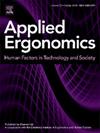自动驾驶中感知态势感知与危险识别的不匹配
IF 3.4
2区 工程技术
Q2 ENGINEERING, INDUSTRIAL
引用次数: 0
摘要
这项研究测试了驾驶员在传统驾驶和自动驾驶条件下的危险识别和/或感知情况意识是否存在差异。共有46名参与者被分配到模拟车辆的非自动“主动”驾驶条件下,直接负责避免危险,或自动“被动”驾驶条件下,他们监测危险并通过手持按钮做出反应。驾驶结束后,参与者完成了一份自我报告,测量他们的处境意识。结果显示了一种不匹配,自动条件下的参与者报告了更强的情况意识,但表现出明显更慢的危险识别,这种表现缺陷在预期和意外危险中都是一致的。这些发现表明,自动驾驶可能与有关自动驾驶汽车能力的不准确的心理模型有关。因此,需要采取以人为本的策略,以确保驾驶员充分认识到自动驾驶汽车识别和应对危险的能力。本文章由计算机程序翻译,如有差异,请以英文原文为准。
The mismatch between perceived situation awareness and hazard recognition in automated driving
This study tested whether drivers' hazard recognition and/or perceived situation awareness differed in traditional versus automated driving conditions. A total of 46 participants were assigned to either a non-automated ‘active’ driving condition of a simulated vehicle and were directly responsible for avoiding hazards or an automated 'passive' condition where they monitored for hazards and responded via a handheld button. Post-drive, participants completed a self-report measure of situation awareness. The results revealed a mismatch where participants in the automated condition reported greater situation awareness but demonstrated significantly slower hazard recognition, with this performance deficit consistent across both anticipation and surprise hazards. These findings suggest that automated driving may be associated with inaccurate mental models concerning the capabilities of automated vehicles. Therefore, human-centred strategies are required to ensure that drivers are fully cognisant of the capabilities of automated vehicles in recognising and responding to hazards.
求助全文
通过发布文献求助,成功后即可免费获取论文全文。
去求助
来源期刊

Applied Ergonomics
工程技术-工程:工业
CiteScore
7.50
自引率
9.40%
发文量
248
审稿时长
53 days
期刊介绍:
Applied Ergonomics is aimed at ergonomists and all those interested in applying ergonomics/human factors in the design, planning and management of technical and social systems at work or leisure. Readership is truly international with subscribers in over 50 countries. Professionals for whom Applied Ergonomics is of interest include: ergonomists, designers, industrial engineers, health and safety specialists, systems engineers, design engineers, organizational psychologists, occupational health specialists and human-computer interaction specialists.
 求助内容:
求助内容: 应助结果提醒方式:
应助结果提醒方式:


